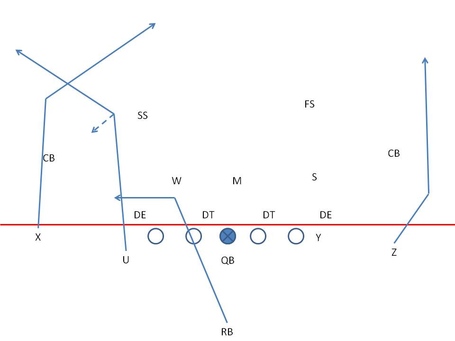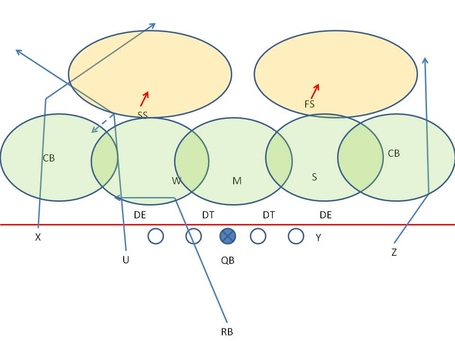Film Review: Adjusting Routes to Coverage
Because Wisconsin has such run game prowess, many of its passing concepts attack the sidelines, away from the box area. In this area, the Badgers will often run "route adjustments" depending on the coverage. These adjustments rely on the quarterback and receiver seeing the same thing, and if they don't, it often leads to bad things. In this post, I'm going to try to piece together where these issues were made and talk about why you have these adjustments within your offense.
This is a defense that is in Cover 2 (you see because Ohio State cornerback Bradley Roby is rolled up underneath before attempting to gain depth since no one threatens the flat). This needs to be a corner route, not a hitch.
The easiest way to show why you use route adjustments is with diagrams.
What you see is that in Cover 2, that hook/curl zone is pretty well covered by the outside linebacker. Throwing the ball there against Cover 2 is very dangerous because you have the safety over the top squeezing down and the outside linebacker gaining depth, meaning the ball needs to be put in a perfect window just to have a shot at a completion. So instead, you run the corner route to open grass. This puts the receiver in a position to gain distance from the safety and pick on the underneath corner.
Now against Cover 3, the opposite is true. The corner is no longer open because there is a cornerback sitting directly in that third. Meanwhile, because of how the coverage has rolled, sitting in the hook/curl zone will come open, as you pick on the flat defender again and work him inside/out rather than high/low.
This sight adjustment is used depending on the safeties. A single high safety (Cover 1, Cover 3) will sit, though against man the route likely will become more of an out route instead of a hitch so that the tight end can gain separation on his defender. Against two high safeties (Cover 2, Cover 4) the No. 2 receiver (second from the outside) will attack the corner. In Cover 4, because the No. 1 receiver (farthest outside) hitches, the cornerback will come up and the defense will essentially play like Cover 2.
Not adjusting to Cover 2
I'm starting on this play, where there is clear miscommunication, because it provides me evidence on the next play. After the play, the tight ends points to himself, saying, "my bad," because he sat down in the hook zone rather than taking the route to the corner.The easiest way to show why you use route adjustments is with diagrams.
Now against Cover 3, the opposite is true. The corner is no longer open because there is a cornerback sitting directly in that third. Meanwhile, because of how the coverage has rolled, sitting in the hook/curl zone will come open, as you pick on the flat defender again and work him inside/out rather than high/low.
This sight adjustment is used depending on the safeties. A single high safety (Cover 1, Cover 3) will sit, though against man the route likely will become more of an out route instead of a hitch so that the tight end can gain separation on his defender. Against two high safeties (Cover 2, Cover 4) the No. 2 receiver (second from the outside) will attack the corner. In Cover 4, because the No. 1 receiver (farthest outside) hitches, the cornerback will come up and the defense will essentially play like Cover 2.
* * * * * * *
To read on about route adjustments, and to see how they are done correctly, follow the link to Bucky's 5th Quarter






Comments
Post a Comment